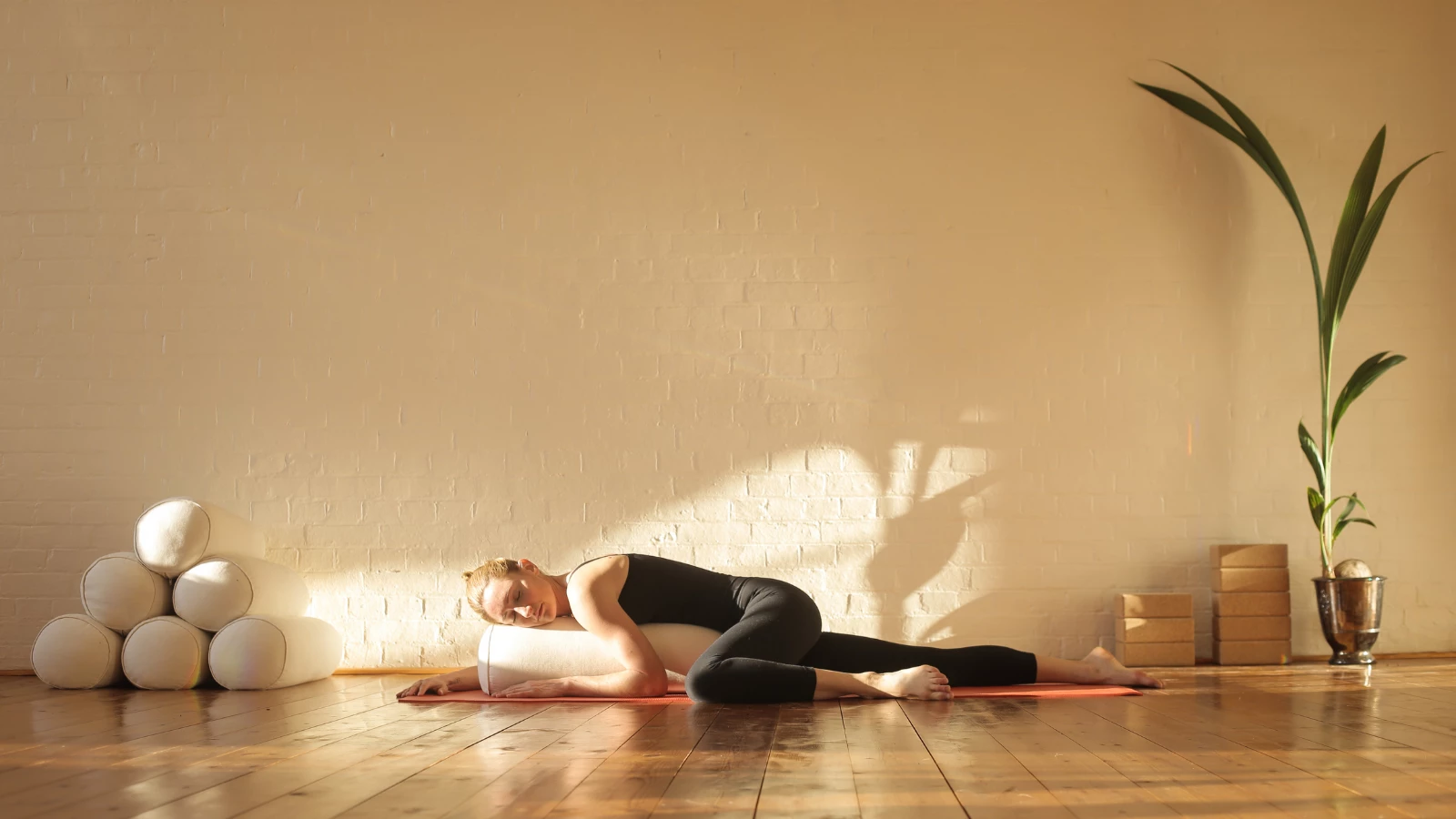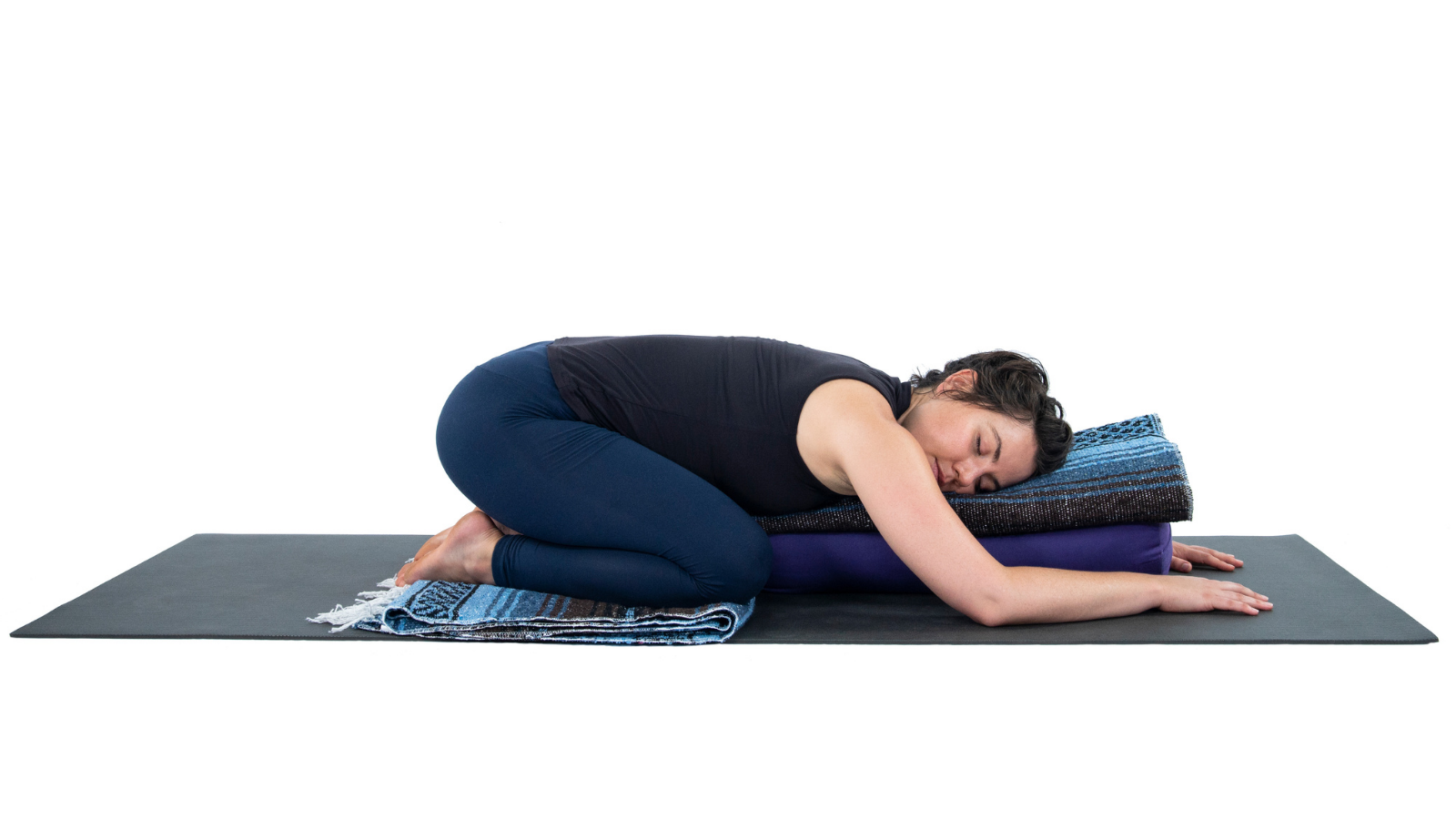Nourish Your Nervous System
A Yoga Practice Reset

Article At A Glance
Settling into stillness allows you to access the inner wisdom that can be found within the depths of your psyche. As if diving deep below the surface of the ocean, you find the slowest moving currents of your soul’s wisdom. Within these depths, you connect to your intuition. As you reside in this deep connection to your heart, you learn to trust this inner knowing, which becomes the guiding compass for your life’s decisions. In order to rest in this place of deep stillness, you must feel safe enough to let go of your defenses, which will allow you to access your parasympathetic nervous system’s relaxation response.
However, reclaiming a healthy relationship to stillness can take time to develop and requires patience. You have to learn how to nourish your nervous system.
Although rest is an integral part of our body’s rhythm, many of us have a complicated relationship to rest. That’s because our culture tends to condition us to believe that our self-worth is based on productivity.
You might feel guilty for resting or believe that it is selfish to take time out. You might fear that you will miss an opportunity if you slow down. Maybe you fear that you will lose momentum or that you will become stagnant. Perhaps you have received messages that you’re lazy if you’re not working hard or being productive.
How Busyness Leads to Burnout
These ingrained messages can cause you to neglect your health or believe that “hard work” is what brings happiness. Sadly, this can lead you to feel disconnected from your deeper self, and you might question the point of all this hard work.
Over time, an addiction to busyness can also lead to burnout, which can affect your endocrine system functioning and overall physical health. Cultivating a nourishing relationship to rest takes consistency and practice. Paradoxically, when you do embrace the need for rest, you tend to be more focused and attentive during the day, which can ultimately allow you to be more productive.
How to Nourish Your Nervous System
 Our yoga practice can become essential at any time of year to help us maintain balance and stay realistic about what we can actually accomplish. The softer side of yoga invites you into restorative shapes that allow you to rest into stillness, nourishing your nervous system by supporting your parasympathetic nervous system.
Our yoga practice can become essential at any time of year to help us maintain balance and stay realistic about what we can actually accomplish. The softer side of yoga invites you into restorative shapes that allow you to rest into stillness, nourishing your nervous system by supporting your parasympathetic nervous system.
A sense of safety is always rooted in choice, and resting in stillness can never be forced. Just as you may need to build up a tolerance to engage in strength training or endurance exercises, you may also need to build up a tolerance for restful states. As you build this tolerance, you might find that your mind speeds up when your body becomes still. Or you might feel restless or notice the urge to fidget. Or you might feel collapsed or immobilized.
Remember that you can move your body freely as needed and that you can turn toward cues that help you recognize that you are safe now. Once you recognize that you are safe, you can practice learning to let go of your vigilance and soften into stillness.
Yin and Restorative Yoga Nourish Your Nervous System
 Restorative yoga focuses on longer holds in restful poses. You might hold a pose for five minutes while allowing yourself to soften into the stillness of the shape. Often, these poses are supported through the use of bolsters, blankets, and blocks.
Restorative yoga focuses on longer holds in restful poses. You might hold a pose for five minutes while allowing yourself to soften into the stillness of the shape. Often, these poses are supported through the use of bolsters, blankets, and blocks.
One form of restorative yoga is called yin yoga, which integrates the Taoist understanding that all of nature carries polarities of yin and yang. Yang represents all that is active, moving, and changing. Yang yoga practices emphasize moving and strengthening the muscles of your body. On the other hand, yin represents that which is stable and unmoving. A yin practice can be thought of as a complement to any active or strengthening practice. It is the soft side of yoga that allows you to nourish your nervous system.
Yin postures focus on your ligaments, tendons, and connective tissue. Since the capacity to stretch the tendons and ligaments is limited compared to the muscles, the joints benefit from longer holds in stillness, which creates healthy stress in these tissues of your body. This is facilitated by engaging in shapes that intelligently, and safely, compress the joints of your hips and lower back by using the weight of your own body in hip-opening, twisting, and forward-folding positions.
At the end of the post, you can explore a short guided restorative practice video to guide you to find “Zen at the wall.”
Your Circadian Rhythm

Our bodies are ruled by rhythm. The rhythmic pulse of your heartbeat and the cyclical nature of your circadian rhythm are two clear examples. Your circadian rhythm is a 24-hour cycle that is responsible for your sleep patterns and helps regulate your hormones, body temperature, hunger cycles, and digestion.
When your circadian rhythm gets offset by jet lag—or by any other type of significant disruption to your schedule—it can impact both your sleep and your digestion. Our bodies appreciate when we go to sleep, wake up, and eat with relative predictability. When we engage in restorative practices and meditation with regularity, our bodies become accustomed to these rhythms as well.
Nourish Your Nervous System with Yoga Nidra—Yogic Sleep
Yoga Nidra involves resting in Relaxation Pose (Savasana) while engaging in a series of guided body-awareness scans. Yoga Nidra typically lasts between 30 and 40 minutes. But if you have a trauma history, it can be beneficial, to begin with, a shorter, 10-minute practice of stillness while you focus your awareness on your breath and bodily sensations.
As needed, you can also adapt your practice to reduce the likelihood of triggering PTSD symptoms by choosing to sit up or keep your eyes open. You can choose to move your body or end the practice at any time. If you would like to try this for yourself, the second video below which offers you an opportunity to explore a trauma-sensitive version of Yoga Nidra for yourself:
Also, read...
Yoga for Stress Relief: 2 Practices for Deep Relaxation
Nourish Your Winter Body with a Restorative Yoga Practice
3 Steps to Practicing Active Happiness
Related courses
Keys to Finding Inner Strength: A Yogic Wisdom Path to Developing Greater Resilience
Somatic Yoga for Fascial Unwinding

Dr. Arielle Schwartz is a licensed clinical psychologist, wife, and mother in Boulder, CO. She offers trainings for therapists, maintains a private practice, and has passions for the outdoors, yoga, and writing. She is also the developer of Resilience-Informed Therapy which applies research on trauma recovery to form a strength-based, trauma treatment model that includes Eye Movement Desensitization and Reprocessing (EMDR), somatic (body-centered) psychology, mindfulness-based therapies, and time-tested relational psychotherapy.


